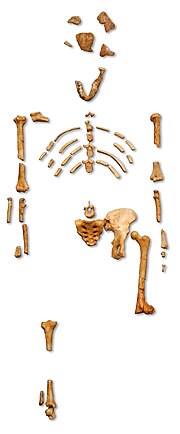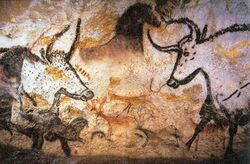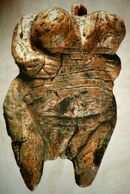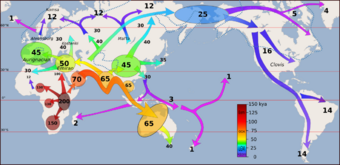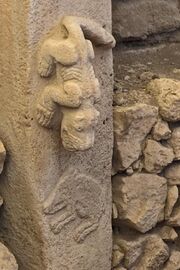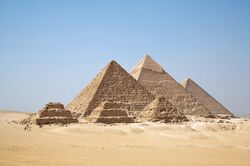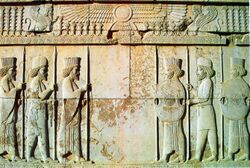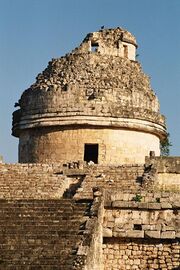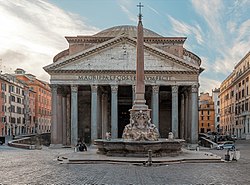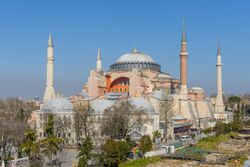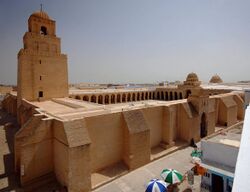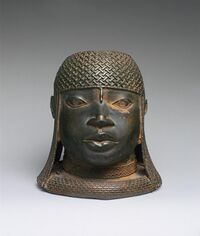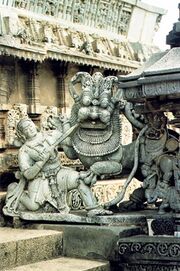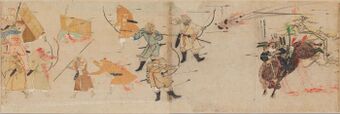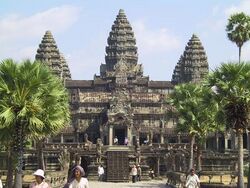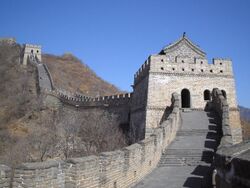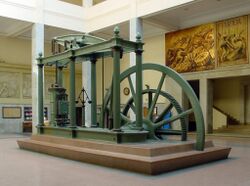Human history
Topic: History
 From HandWiki - Reading time: 48 min
From HandWiki - Reading time: 48 min
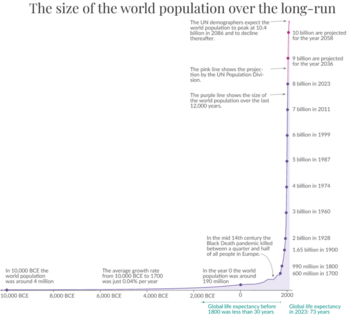
Modern humans evolved in Africa around 300,000 years ago and initially lived as hunter-gatherers. They migrated out of Africa during the Last Glacial Period (Ice Age) and had populated most of the Earth by the time the Ice Age ended 12,000 years ago.
Soon afterward, the Agricultural Revolution began in the fertile river valleys of West Asia: humans began the systematic husbandry of plants and animals, and many humans transitioned from a nomadic life to a sedentary existence as farmers in permanent settlements. The growing complexity of human societies necessitated systems of accounting and writing.
During the late Bronze Age, Hinduism developed in the Indian subcontinent, while the Axial Age witnessed the growth and institutionalization of religions such as Buddhism, Confucianism, Jainism, Judaism, Taoism, and Zoroastrianism. As civilizations flourished, ancient history saw the rise and fall of empires. Subsequent post-classical history, the "Middle Ages" from about 500 to 1500 CE, witnessed the rise of Christianity and Islam.
The early modern period, from about 1500 to 1800 CE, saw the Age of Discovery and the Age of Enlightenment. By the 18th century, the accumulation of knowledge and technology had reached a critical mass that brought about the Industrial Revolution and began the late modern period, which started around 1800 CE and continues.
The foregoing historical periodization (prehistory followed by the ancient, post-classical, early modern, and late modern periods) applies best to the history of Europe. Elsewhere, including China and India, historical timelines unfolded differently up to the 18th century. By then, however, due to extensive international trade and colonization, the histories of most civilizations had become substantially intertwined. Over the last quarter-millennium, the rates of growth of human populations, agriculture, industry, commerce, scientific knowledge, technology, communications, weapons destructiveness, and environmental degradation[lower-alpha 1] have greatly accelerated.
Prehistory (c. 3.3 million years ago – c. 3000 BCE)
Human evolution
Humans evolved in Africa.[4] Genetic measurements indicate that the ape lineage which would lead to Homo sapiens diverged from the lineage that would lead to chimpanzees and bonobos, the closest living relatives of modern humans, between 7 million and 5 million years ago.[5] The term hominin denotes human ancestors that lived after the split with chimpanzees and bonobos,[6] including many species and at least two distinct genera: Australopithecus and Homo.[7] Other fossil specimens such as Paranthropus, Kenyanthropus, and Orrorin may represent additional genera, but paleontologists debate their taxonomic status.[7] The early hominins such as Australopithecus had the same brain size as apes but were distinguished from apes by walking on two legs, an adaptation perhaps associated with a shift from forest to savanna habitats.[8] Hominins began to use rudimentary stone tools c. 3.3 million years ago,[lower-alpha 2] marking the advent of the Paleolithic era.[12][13]
The genus Homo evolved from Australopithecus.[14] The earliest record of Homo is the 2.8 million-year-old specimen LD 350-1 from Ethiopia,[15] and the earliest named species is Homo habilis which evolved by 2.3 million years ago.[16] The most important difference between Homo habilis and Australopithecus was an increase in brain size.[17] H. erectus (the African variant is sometimes called H. ergaster) evolved by 2 million years ago[18][lower-alpha 3] and was the first hominin species to leave Africa and disperse across Eurasia.[20] Perhaps as early as 1.5 million years ago, but certainly by 250,000 years ago, hominins began to use fire for heat and cooking.[21][22]
Beginning about 500,000 years ago, Homo diversified into many new species of archaic humans such as the Neanderthals in Europe, the Denisovans in Siberia, and the diminutive H. floresiensis in Indonesia.[23][24] Human evolution was not a simple linear or branched progression but involved interbreeding between related species.[25][26] Genomic research has shown that hybridization between substantially diverged lineages was common in human evolution.[27] DNA evidence suggests that several genes of Neanderthal origin are present among all non-sub-Saharan African populations, and Neanderthals and other hominins, such as Denisovans, may have contributed up to 6% of their genome to present-day non-sub-Saharan African humans.[28][29]
Early humans
Homo sapiens emerged in Africa around 300,000 years ago from a species commonly designated as either H. heidelbergensis or H. rhodesiensis.[30] Humans continued to develop over the succeeding millennia, and by 100,000 years ago, were already using jewellery and ocher to adorn the body.[31] By 50,000 years ago, they exhibited many characteristic behaviors such as burial of the dead, use of projectile weapons, and seafaring.[32] One of the most important changes (the date of which is unknown) was the development of syntactic language, which dramatically improved humans' ability to communicate.[33] Signs of early artistic expression can be found in the form of cave paintings and sculptures made from ivory, stone, and bone, implying a form of spirituality generally interpreted as animism[34] or shamanism.[35] Paleolithic humans lived as hunter-gatherers and were generally nomadic.[36] They inhabited grasslands or sparsely wooded areas and avoided dense forest cover.[37]
The migration of anatomically modern humans out of Africa took place in multiple waves beginning 194,000–177,000 years ago.[38][lower-alpha 4] The dominant view among scholars (Southern Dispersal) is that the early waves of migration died out and all modern non-Africans are descended from a single group that left Africa 70,000–50,000 years ago.[42][43][44] H. sapiens proceeded to colonize all the continents and larger islands, arriving in Australia 65,000 years ago,[45] Europe 45,000 years ago,[42] and the Americas 21,000 years ago.[46] These migrations occurred during the most recent Ice Age, when temperate regions of today were extremely inhospitable.[47] Nevertheless, by the end of the Ice Age some 12,000 years ago, humans had colonized nearly all ice-free parts of the globe.[48] Human expansion coincided with both the Quaternary extinction event and Neanderthal extinction.[49] These extinctions were probably caused by climate change, human activity, or a combination of the two.[50][51]
Rise of agriculture
Beginning around 10,000 BCE, the Neolithic Revolution marked the development of agriculture, which fundamentally changed the human lifestyle.[52] Agriculture began independently in different parts of the globe,[53] and included a diverse range of taxa, in at least 11 separate centers of origin.[54] Cereal crop cultivation and animal domestication had occurred in Mesopotamia by at least 8500 BCE in the form of wheat, barley, sheep, and goats.[55] The Yangtze River Valley in China domesticated rice around 8000 BCE; the Yellow River Valley may have cultivated millet by 7000 BCE.[56] Pigs were the most important domesticated animal in early China.[57] People in Africa's Sahara cultivated sorghum and several other crops between 8000 and 5000 BCE,[lower-alpha 5] while other agricultural centers arose in the Ethiopian Highlands and the West African rainforests.[59] In the Indus River Valley, crops were cultivated by 7000 BCE and cattle were domesticated by 6500 BCE.[60] In the Americas, squash was cultivated by at least 8500 BCE in South America, and domesticated arrowroot appeared in Central America by 7800 BCE.[61] Potatoes were first cultivated in the Andes of South America, where the llama was also domesticated.[62][63] It is likely that women played a central role in plant domestication throughout these developments.[64][65]
There is no scholarly consensus on why the Neolithic Revolution occurred.[66] For example, according to some theories, agriculture was the result of an increase in population which led people to seek out new food sources, while in others agriculture was the cause of population growth as the food supply improved.[67] Other proposed factors include climate change, resource scarcity, and ideology.[68] The effects of the transition to agriculture are better understood: it created food surpluses that could support people not directly engaged in food production,[69] permitting far denser populations and the creation of the first cities and states.[52]
Cities were centers of trade, manufacturing, and political power.[70] Cities established a symbiosis with their surrounding countrysides, absorbing agricultural products and providing, in return, manufactured goods and varying degrees of political control.[71][72] Early proto-cities appeared at Jericho and Çatalhöyük around 6000 BCE.[73] Pastoral societies based on nomadic animal herding also developed, mostly in dry areas unsuited for plant cultivation such as the Eurasian Steppe or the African Sahel.[74] Conflict between nomadic herders and sedentary agriculturalists occurred frequently and became a recurring theme in world history.[75]
Metalworking was first used in the creation of copper tools and ornaments around 6400 BCE.[59] Gold and silver soon followed, primarily for use in ornaments.[59] The need for metal ores stimulated trade, as many areas of early human settlement lacked the necessary ores.[76] The first signs of bronze, an alloy of copper and tin, date to around 4500 BCE,[77] but the alloy did not become widely used until the third millennium BCE.[78]
Neolithic societies usually worshiped ancestors, sacred places, or anthropomorphic deities.[79] The vast complex of Göbekli Tepe in Turkey, dated 9500–8000 BCE,[80] is a spectacular example of a Neolithic religious or civic site.[81] It may have been built by hunter-gatherers rather than a sedentary population.[81] Elaborate mortuary practices developed in the Levant during the Pre-Pottery Neolithic B, in which certain high-status individuals were buried under the floors of houses and the graves were later re-opened for the skulls to be removed.[82] Some of the skulls were then covered in plaster, painted, and displayed in public.[83][84]
Ancient history (c. 3000 BCE – c. 500 CE)
Cradles of civilization
The Bronze Age saw the development of cities and civilizations.[85][86] Early civilizations arose close to rivers, first in Mesopotamia (3000 BCE) with the Tigris and Euphrates,[87][88] followed by the Egyptian civilization along the Nile River (3000 BCE),[89][90] the Indus Valley civilization in Pakistan and northwestern India (2500 BCE),[91][92][93] and the Chinese civilization along the Yangtze and Yellow Rivers (2200 BCE).[lower-alpha 6][94]
These societies developed a number of unifying characteristics, including a central government, a complex economy and social structure, systems for keeping records, and distinct cultures and religions.[97] These cultures variously invented the wheel,[98] mathematics,[99] bronze-working,[100] sailing boats,[101] the potter's wheel,[100] woven cloth,[102] construction of monumental buildings,[102] and writing.[103] Polytheistic religions developed, centered on temples where priests and priestesses performed sacrificial rites.[104]
Writing facilitated the administration of cities, the expression of ideas, and the preservation of information.[105] Writing may have independently developed in at least four ancient civilizations: Mesopotamia (3300 BCE),[106] Egypt (around 3250 BCE),[107][108] China (1200 BCE),[109] and lowland Mesoamerica (by 650 BCE).[110] Among the earliest surviving written religious scriptures are the Egyptian Pyramid Texts, the oldest of which date to between 2400 and 2300 BCE.[111]
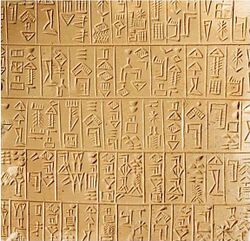
Sumer, located in Mesopotamia, is the first known complex civilization, having developed the first city-states in the 4th millennium BCE.[112] It was these cities that produced the earliest known form of writing, cuneiform script.[113] Cuneiform writing began as a system of pictographs, whose pictorial representations eventually became simplified and more abstract.[113] Cuneiform texts were written by using a blunt reed as a stylus to draw symbols upon clay tablets.[114]
Transport was facilitated by waterways—by rivers and seas.[115] The Mediterranean Sea, at the juncture of three continents, fostered the projection of military power and the exchange of goods, ideas, and inventions.[116] This era also saw new land technologies, such as horse-based cavalry and chariots, that allowed armies to move faster.[100] Trade became increasingly important as urban societies exchanged manufactured goods for raw materials from distant lands, creating vast commercial networks and the beginnings of archaic globalization.[117] Bronze production, for example, required the import of tin to Southwest Asia from as far away as England,[118] and Indus Valley seals and gems have been found in Mesopotamia.[119]
The growth of cities was often followed by the establishment of states and empires.[120] In Mesopotamia, there prevailed a pattern of independent warring city-states and of a loose hegemony shifting from one city to another.[121] In Egypt, by contrast, the initial division into Upper and Lower Egypt was followed by the unification of all the valley around 3100 BCE.[122] Around 2600 BCE, the Indus Valley civilization built major cities at Harappa and Mohenjo-daro and developed a writing system of over 400 symbols, which remains undeciphered.[123][124] China entered the Bronze Age by 2900 BCE.[125] The Shang dynasty (1766–1045 BCE) was the first to use writing, inscribing the results of divination ceremonies on oracle bones – ox shoulder blades and turtle shells.[126][127] In the 25th–21st centuries BCE, the empires of Akkad and the Neo-Sumerians arose in Mesopotamia.[128] In Crete, the Minoan civilization emerged by 2000 BCE and is regarded as the first civilization in Europe.[129]
Over the following millennia, civilizations developed across the world.[130] By 1600 BCE, Mycenaean Greece began to develop.[131] It flourished until the Late Bronze Age collapse that affected many Mediterranean civilizations between 1300 and 1000 BCE.[132] In India, this era was the Vedic period (1750–600 BCE), which laid the foundations of Hinduism and other cultural aspects of early Indian society, and ended in the 6th century BCE.[133] The Vedas contain the earliest references to India's caste system, which divided society into four hereditary classes: priests, warriors, farmers and traders, and laborers.[134] From around 550 BCE, many independent kingdoms and republics known as the Mahajanapadas were established across the subcontinent.[135]
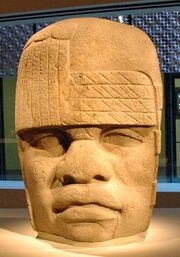
Speakers of the Bantu languages began expanding across Central and Southern Africa as early as 3000 BCE.[136] Their expansion and encounters with other groups resulted in the spread of mixed farming and ironworking throughout sub-Saharan Africa, and produced societies such as the Nok culture in modern Nigeria by 500 BCE.[137] The Lapita culture emerged in the Bismarck Archipelago near New Guinea around 1500 BCE and colonized many uninhabited islands of Remote Oceania, reaching as far as Samoa by 700 BCE.[138]
In the Americas, the Norte Chico culture emerged in coastal Peru around 3100 BCE.[139] The Norte Chico built public monumental architecture at the city of Caral, dated 2627–1977 BCE.[140][141] The later Chavín polity is sometimes described as the first Andean state.[142] It centered on the religious site at Chavín de Huantar, a place of pilgrimage and consumption of psychoactive substances.[143] Other important Andean cultures include the Moche, whose ceramics depict many aspects of daily life, and the Nazca, who created animal-shaped designs in the desert called Nazca lines.[144] The Olmecs of Mesoamerica developed by about 1200 BCE[145] and are known for the colossal stone heads that they carved from basalt.[146] They also devised the Mesoamerican calendar that was used by later cultures such as the Maya and Teotihuacan.[147] Societies in North America were primarily egalitarian hunter-gatherers, supplementing their diet with the plants of the Eastern Agricultural Complex.[148] They came together, seemingly voluntarily, to build earthworks such as Watson Brake (4000 BCE) and Poverty Point (3600 BCE), both in Louisiana.[149]
Axial Age
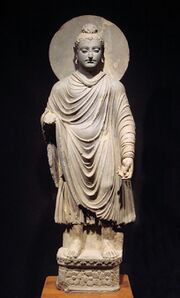
From 800 to 200 BCE,[150] the "Axial Age" saw the development of a set of transformative philosophical and religious ideas, mostly independently, in many different places.[151] Chinese Confucianism,[152] Indian Buddhism and Jainism,[153] and Jewish monotheism all developed during this period.[154] Persian Zoroastrianism began earlier, perhaps around 1000 BCE, but was institutionalized by the Achaemenid Empire during the Axial Age.[155] New philosophies took hold in Greece during the 5th century BCE, epitomized by thinkers such as Plato and Aristotle.[156]
Axial Age ideas were tremendously important for subsequent intellectual and religious history. Confucianism was one of the three schools of thought that came to dominate Chinese thinking, along with Taoism and Legalism.[157] The Confucian tradition, which would become particularly influential, looked for political morality not to the force of law but to the power and example of tradition.[158] Confucianism would later spread to Korea and Japan.[159] Buddhism reached China during the Han dynasty and spread widely, with 30,000 Buddhist temples in northern China alone by the 7th century CE.[160] Buddhism became the main religion in much of South, Southeast, and East Asia.[161] The Greek philosophical tradition[162] diffused throughout the Mediterranean world and as far as India, starting in the 4th century BCE after the conquests of Alexander the Great of Macedon.[163] Both Christianity and Islam developed from the beliefs of Judaism.[164]
Regional empires
The millennium from 500 BCE to 500 CE saw a series of empires of unprecedented size develop. Well-trained professional armies, unifying ideologies, and advanced bureaucracies created the possibility for emperors to rule over large domains whose populations could attain numbers upwards of tens of millions of subjects.[165] International trade also expanded, most notably the massive trade routes in the Mediterranean Sea, the maritime trade web in the Indian Ocean, and the Silk Road.[166]
There were a number of regional empires during this period. The kingdom of the Medes helped to destroy the Assyrian Empire in tandem with the nomadic Scythians and the Babylonians.[167] Nineveh, the capital of Assyria, was sacked by the Medes in 612 BCE.[168] The Median Empire gave way to successive Iranian states, including the Achaemenid (550–330 BCE),[169] Parthian (247 BCE–224 CE),[170][171] and Sasanian Empires (224–651 CE).[171]
Several empires began in modern-day Greece. The Delian League, founded in 477 BCE,[172] and the Athenian Empire (454–404 BCE) were two such examples.[173] Later, Alexander the Great of Macedon (356–323 BCE) founded an empire extending from present-day Greece to India.[174][175] The empire divided shortly after his death, but resulted in the spread of Greek culture throughout conquered regions, a process referred to as Hellenization.[176] The Hellenistic period lasted from 323 to 31 BCE.[177]
In South Asia, Chandragupta Maurya founded the Maurya Empire (320–185 BCE), which flourished under Ashoka the Great.[178][179] From the 4th to 6th centuries CE, the Gupta Empire oversaw the period referred to as ancient India's golden age.[180] The ensuing stability contributed to heralding in an efflorescence of Hindu and Buddhist culture in the 4th and 5th centuries, as well as major advances in science and mathematics.[181] In South India, three prominent Dravidian kingdoms emerged: the Cheras, Cholas, and Pandyas.[182]
In Europe, the Roman Republic was founded in the 6th century BCE[183] and began expanding its territory in the 3rd century BCE.[184] The Republic became an empire and by the time of Augustus (63 BCE–14 CE), it had established dominion over most of the Mediterranean Sea.[185] The empire would continue to grow, controlling much of the land from England to Mesopotamia, reaching its greatest extent under Trajan (died 117 CE).[186] In the 4th century CE, the empire split into western and eastern regions, with (usually) separate emperors.[187] The Western Roman Empire would fall, in 476 CE, to German influence under Odoacer.[187] The Eastern Roman Empire, now known as the Byzantine Empire, with its capital at Constantinople, would continue for another thousand years until the city was conquered by the Ottoman Empire in 1453.[188] During most of its existence, the Byzantine Empire was one of the most powerful economic, cultural, and military forces in Europe,[189][190] and Constantinople is generally considered to be the center of "Eastern Orthodox civilization".[191][192]
In China, the Qin dynasty (221–206 BCE), the first imperial dynasty of China, was followed by the Han dynasty (202 BCE–220 CE).[193] The Han dynasty was comparable in power and influence to the Roman Empire that lay at the other end of the Silk Road.[194] As economic prosperity fueled their military expansion, the Han conquered parts of Mongolia, Central Asia, Manchuria, Korea, and northern Vietnam.[195] As with other empires during the classical period, Han China advanced significantly in the areas of government, education, science, and technology.[196][197] The Han invented cast iron, and created finely wrought bronze figurines.[198]
In Africa, the Kingdom of Aksum, centered in present-day Ethiopia, established itself by the 1st century CE as a major trading empire, dominating its neighbors in South Arabia and Kush and controlling the Red Sea trade.[199] It minted its own currency and carved enormous monolithic stelae to mark its emperors' graves.[200]
Successful regional empires were also established in the Americas, arising from cultures established as early as 2500 BCE.[201] In Mesoamerica, vast pre-Columbian societies were built, the most notable being the Zapotec civilization (700 BCE–1521 CE),[202][203] and the Maya civilization, which reached its highest state of development during the Mesoamerican classic period (c. 250–900 CE),[204] but continued throughout the post-classic period.[205] The great Maya city-states slowly rose in number and prominence, and Maya culture spread throughout the Yucatán and surrounding areas.[206] The Maya developed a writing system and were the first to use the concept of zero in their mathematics.[207] West of the Maya area, in central Mexico, the city of Teotihuacan prospered due to its control of the obsidian trade.[208] Its power peaked around 450 CE, when its 125,000–150,000 inhabitants made it one of the world's largest cities.[209]
Technology developed sporadically in the ancient world.[210] There were periods of rapid technological progress, such as the Greco-Roman era in the Mediterranean region.[211] There were also periods of technological decay, as during the Roman Empire's decline and fall and the ensuing early medieval period.[212] Two of the most important innovations were paper (China, 1st and 2nd centuries CE)[213] and the stirrup (India, 2nd century BCE and Central Asia, 1st century CE),[214] both of which diffused widely throughout the world. The Chinese also learned to make silk and built massive engineering projects such as the Great Wall of China and the Grand Canal.[215] The Romans were also accomplished builders, inventing concrete and perfecting the use of arches in construction.[216]
Most ancient societies had slaves.[217] Slavery was particularly prevalent in Athens and Rome, where slaves made up a large proportion of the population and were foundational to the economy.[218] Most societies were also patriarchal, with men controlling more political and economic power than women.[219]
Declines, falls, and resurgence
The ancient empires faced common problems associated with maintaining huge armies and supporting a central bureaucracy.[220] In Rome and Han China, the state began to decline, and barbarian pressure on the frontiers hastened internal dissolution.[220] The Han dynasty fell into civil war in 220 CE, beginning the Three Kingdoms period, while its Roman counterpart became increasingly decentralized and divided about the same time in what is known as the Crisis of the Third Century.[221] From the Eurasian Steppe, horse-based nomads dominated a large part of the continent.[222] The development of the stirrup and the use of horse archers made the nomads a constant threat to sedentary civilizations.[223]
The gradual breakup of the Roman Empire coincided with the spread of Christianity outward from West Asia.[224] The Western Roman Empire fell under the domination of Germanic tribes in the 5th century,[225] and these polities gradually developed into a number of warring states, all associated in one way or another with the Catholic Church.[226] The remaining part of the Roman Empire, in the eastern Mediterranean, continued as what came to be called the Byzantine Empire.[227] Centuries later, a limited unity would be restored to Western Europe through the establishment in 962 of a revived "Roman Empire",[228] later called the Holy Roman Empire,[229] comprising a number of states in what is now Germany, Austria, Switzerland, Czechia, Belgium, Italy, and parts of France.[230][231]
In China, dynasties would rise and fall, but, in sharp contrast to the Mediterranean-European world, dynastic unity would be restored.[232] After the fall of the Eastern Han dynasty and the demise of the Three Kingdoms, nomadic tribes from the north began to invade, causing many Chinese people to flee southward.[233] The Sui dynasty successfully reunified China in 589,[234] and laid the foundations for a golden age under the Tang dynasty (618–907).[235][236]
Post-classical history (c. 500 CE – c. 1500 CE)
The term "post-classical era", though derived from the name of the era of "classical antiquity", takes in a broader geographic sweep.[237] The era is commonly dated from the 5th-century fall of the Western Roman Empire.[238]
From the 10th to 13th centuries, the Medieval Warm Period in the northern hemisphere aided agriculture and led to population growth in parts of Europe and Asia.[239] It was followed by the Little Ice Age, which, along with the plagues of the 14th century, put downward pressure on the population of Eurasia.[239] Some of the major inventions of the period were gunpowder, printing, and the compass, all of which originated in China.[240]
The post-classical period encompasses the early Muslim conquests, the subsequent Islamic Golden Age, and the commencement and expansion of the Arab slave trade, followed by the Mongol invasions and the founding of the Ottoman Empire.[241] South Asia saw a series of middle kingdoms of India, followed by the establishment of Islamic empires in India.[242]
In West Africa, the Mali and Songhai Empires rose.[243] On the southeast coast of Africa, Arabic ports were established where gold, spices, and other commodities were traded. This allowed Africa to join the Southeast Asia trading system, bringing it contact with Asia; this resulted in the Swahili culture.[244]
China experienced the successive Sui, Tang, Song, Yuan, and early Ming dynasties.[245] Middle Eastern trade routes along the Indian Ocean, and the Silk Road through the Gobi Desert, provided limited economic and cultural contact between Asian and European civilizations.[210] During the same period, civilizations in the Americas, such as the Mississippians,[246] Aztecs,[247] Maya,[248] and Inca reached their zenith.[249]
Greater Middle East
Prior to the advent of Islam in the 7th century, the Middle East was dominated by the Byzantine and Sasanian Empires, which frequently fought each other for control of several disputed regions.[250] This was also a cultural battle, with Byzantine Christian culture competing against Persian Zoroastrian traditions.[251] The birth of Islam created a new contender that quickly surpassed both of these empires.[252] The new religion greatly affected the history of the Old World, especially the Middle East.[253]
From their center in the Arabian Peninsula, Muslims began their expansion during the 7th century.[254] By 750 CE, they came to conquer most of the Middle East, North Africa, and parts of Europe,[255] ushering in an era of learning, science, and invention known as the Islamic Golden Age.[256] The knowledge and skills of ancient Greece and Persia were preserved in the post-classical era by Muslims,[256] who also added new and important innovations from outside, such as the manufacture of paper from China[257] and decimal positional numbering from India.[258] Islamic civilization expanded both by conquest and on the basis of its merchant economy.[259] Merchants brought goods and their Islamic faith to China, India, Southeast Asia, and Africa.[260]
The crusading movement was a religiously motivated European effort to roll back Muslim territory and regain control of the Holy Land.[261] It was ultimately unsuccessful and served more to weaken the Byzantine Empire, especially with the sack of Constantinople in 1204.[262] Arab domination of the region ended in the mid-11th century with the arrival of the Seljuk Turks, migrating south from the Turkic homelands.[263] In the early 13th century, a new wave of invaders, the Mongols, swept through the region but were eventually eclipsed by the Turks and the founding of the Ottoman Empire in modern-day Turkey around 1280.[241]
North Africa saw the rise of polities established by the Berbers, such as Marinid Morocco, Zayyanid Algeria, and Hafsid Tunisia. [264] The coastal region was known to Europeans as the Barbary Coast. Pirates based in North African ports conducted operations that included capturing merchant ships and raiding coastal settlements.[265] Thousands of European captives were sold in North African markets that were part of the Barbary slave trade.[265]
The Caucasus was fought over in a series of wars between the Byzantine and Sasanian Empires. However, the two opposing powers became exhausted due to continuous conflict. Hence, the Rashidun Caliphate was able to freely expand into the region during the early Muslim conquests.[266] The Seljuk Turks later subjugated Armenia and Georgia in the 11th century. The Mongols subsequently invaded the Caucasus in the 13th century.[267]
Central Asia faced incursions from both the Arabs and the Chinese. China expanded into Central Asia during the Sui dynasty (581–618).[268] They were confronted by Turkic nomads, who were becoming the most dominant ethnic group in Central Asia.[269][270] Originally the relationship was largely cooperative but in 630, the Tang dynasty began an offensive against the Turks by capturing areas of the Ordos Desert.[271] In the 8th century, Islam began to penetrate the region and soon became the sole faith of most of the population, though Buddhism remained strong in the east.[272] The desert nomads of Arabia could militarily match the nomads of the steppe, and the Umayyad Caliphate gained control over parts of Central Asia.[269] The Hephthalites were the most powerful of the nomad groups in the 5th and 6th centuries, and controlled much of the region.[273] From the 9th to 13th centuries, the region was divided among several powerful states, including the Samanid,[274] Seljuk,[275] and Khwarazmian Empires. In 1370, Timur, a Turkic leader in the Mongol military tradition, conquered most of the region and founded the Timurid Empire.[276] Timur's large empire collapsed soon after his death,[277] but his descendants retained control of a core area in Central Asia and Iran.[278] They oversaw the Timurid Renaissance of art and architecture.[279]
Europe
Since at least the 4th century, Christianity, primarily Catholicism,[280] and later Protestantism,[281][282] has played a prominent role in the shaping of Western civilization.[283][284] Europe during the Early Middle Ages was characterized by depopulation, deurbanization, and barbarian invasions, all of which had begun in late antiquity.[285] The barbarian invaders formed their own new kingdoms in the remains of the Western Roman Empire.[286] Although there were substantial changes in society and political structures, most of the new kingdoms incorporated existing Roman institutions.[287] Christianity expanded in Western Europe, and monasteries were founded.[288] In the 7th and 8th centuries, the Franks under the Carolingian dynasty established an empire covering much of Western Europe;[289] it lasted until the 9th century, when it succumbed to pressure from new invaders—the Vikings, Magyars, and Arabs.[290]
During the High Middle Ages, which began after 1000, the population of Europe increased as technological and agricultural innovations allowed trade to flourish and crop yields to increase.[291] Manorialism, the organization of peasants into villages that owed rents and labor service to nobles, and vassalage, a political structure whereby knights and lower-status nobles owed military service to their overlords in return for the right to rents from lands and manors, were two of the ways of organizing medieval society that developed during the Middle Ages.[292] Kingdoms became more centralized after the decentralizing effects of the breakup of the Carolingian Empire.[293] In 1054, the Great Schism between the Catholic and Eastern Orthodox Churches led to the prominent cultural differences between Western and Eastern Europe.[294] The Crusades were a series of religious wars waged by Christians to wrest control of the Holy Land from the Muslims and succeeded for long enough to establish some Crusader states in the Levant.[295] Italian merchants imported slaves to work in households or in sugar processing.[296] Intellectual life was marked by scholasticism and the founding of universities, while the building of Gothic cathedrals and churches was one of the outstanding artistic achievements of the age.[297]
The Mongols reached Europe in 1236 and conquered Kievan Rus', along with briefly invading Poland and Hungary.[298] Lithuania cooperated with the Mongols but remained independent and in the late 14th century formed a personal union with Poland.[299] The Late Middle Ages were marked by difficulties and calamities.[300] Famine, plague, and war devastated the population of Western Europe.[301] The Black Death alone killed approximately 75 to 200 million people between 1347 and 1350.[302][303] It was one of the deadliest pandemics in human history. Starting in Asia, the disease reached the Mediterranean and Western Europe during the late 1340s,[304] and killed tens of millions of Europeans in six years; between a quarter and a third of the population perished.[305]
The Middle Ages witnessed the first sustained urbanization of Northern and Western Europe and lasted until the beginning of the early modern period in the 16th century,[306] marked by the rise of nation states,[307] the birth of humanism in the Renaissance,[308] the division of Western Christianity in the Reformation,[309] and the beginnings of European colonial expansion.[310]
Sub-Saharan Africa
Medieval sub-Saharan Africa was home to many different civilizations. In the Horn of Africa, the Kingdom of Aksum declined in the 7th century.[311] The Zagwe dynasty that later emerged was famed for its rock cut architecture at Lalibela.[312] The Zagwe would then fall to the Solomonic dynasty who claimed descent from the Aksumite emperors[313] and would rule the country well into the 20th century.[314]
In the West African Sahel region, many Islamic empires rose, such as the Ghana, Mali, Songhai, and Kanem–Bornu Empires.[315] They controlled the trans-Saharan trade in gold, salt, and slaves.[316] West Africa became the world's largest gold exporter by the 14th century.[317]
South of the Sahel, civilizations rose in the coastal forests. These include the Yoruba city of Ifẹ, noted for its art,[318] and the Oyo Empire,[319] the Edo Kingdom of Benin centered in Benin City,[320] the Igbo Kingdom of Nri that produced advanced bronze art at Igbo-Ukwu,[321] and the Akan who are noted for their intricate architecture.[322]
Central Africa saw the formation of several states, including the Kingdom of Kongo.[323] In what is now modern Southern Africa, native Africans created various kingdoms such as the Kingdom of Mutapa (Monomotapa).[324] They flourished through trade with the Swahili on the East African coast.[325] They built large defensive stone structures without mortar such as Great Zimbabwe, capital of the Kingdom of Zimbabwe,[326] and Khami, capital of the Kingdom of Butua.[327] The Swahili themselves were the inhabitants of the East African coast from Kenya to Mozambique who traded extensively with Arabs, who introduced them to Islam.[328] They built many port cities such as Mombasa, Mogadishu, and Kilwa, which were known to Islamic geographers.[328]
Seafarers from Southeast Asia colonized Madagascar sometime between the 4th and 9th centuries,[329] creating what geographer Jared Diamond called "the single most astonishing fact of human geography".[330] To reach Madagascar, the settlers crossed 6,000 miles of ocean in sailing canoes,[331] probably without maps or compasses.[330] A wave of Bantu-speaking migrants from southeastern Africa also arrived in Madagascar around 1000 CE.[332]
South Asia
After the fall (550 CE) of the Gupta Empire, North India was divided into a complex and fluid network of smaller kingly states.[333] Early Muslim incursions began in the northwest in 711 CE, when the Arab Umayyad Caliphate conquered much of present-day Pakistan.[255] The Arab military advance was largely halted at that point, but Islam still spread in India, largely due to the influence of Arab merchants along the western coast.[244] The 9th century saw a Tripartite Struggle for control of North India, among the Pratihara, Pala, and Rashtrakuta Empires.[334]
Post-classical dynasties in South India included those of the Chalukyas, Hoysalas, and Cholas.[335] Literature, architecture, sculpture, and painting flourished under the patronage of these kings.[336] Some of the other important states that emerged in South India during this time included the Bahmani Sultanate and Vijayanagara Empire.[337]
Northeast Asia
After a period of relative disunity, China was reunified by the Sui dynasty in 589[234] and under the succeeding Tang dynasty (618–907) China entered a golden age.[338] The Sui and Tang instituted the long-lasting imperial examination system, under which administrative positions were open only to those who passed an arduous test on Confucian thought and the Chinese classics.[339][340] China competed with Tibet (618–842) for control of areas in Inner and Central Asia.[341] However, the Tang dynasty eventually splintered. After half a century of turmoil, the Song dynasty reunified much of China.[342] Pressure from nomadic empires to the north became increasingly urgent.[343] By 1127, northern China had been lost to the Jurchens in the Jin–Song Wars, and the Mongols conquered all of China in 1279.[344] After about a century of Mongol Yuan dynasty rule, the ethnic Chinese reasserted control with the founding of the Ming dynasty in 1368.[343]
In Japan, the imperial lineage was established during the 3rd century CE, and a centralized state developed during the Yamato period (c. 300–710).[345] Buddhism was introduced, and there was an emphasis on the adoption of elements of Chinese culture and Confucianism.[346] The Nara period (710–794) was characterized by the appearance of a nascent literary culture, as well as the development of Buddhist-inspired artwork and architecture.[347][348] The Heian period (794–1185) saw the peak of imperial power, followed by the rise of militarized clans and the samurai.[349] It was during the Heian period that Murasaki Shikibu penned The Tale of Genji, sometimes considered the world's first novel.[350] From 1185 to 1868, Japan was dominated by powerful regional lords (daimyos) and the military rule of warlords (shoguns) such as the Ashikaga and Tokugawa shogunates.[351][352] The emperor remained, but mostly as a figurehead,[353] and the power of merchants grew.[354]
Postclassical Korea saw the end of the Three Kingdoms era, the three kingdoms being Goguryeo, Baekje, and Silla.[355] Silla conquered Baekje in 660, and Goguryeo in 668,[356] marking the beginning of the Northern and Southern States period, with Unified Silla in the south and Balhae, a successor state to Goguryeo, in the north.[357] In 892 CE, this arrangement reverted to the Later Three Kingdoms, with Goguryeo (then called Taebong and eventually named Goryeo) emerging as dominant, unifying the entire peninsula by 936.[358] The founding Goryeo dynasty ruled until 1392, succeeded by the Joseon dynasty,[359] which ruled for approximately 500 years.[360]
In Mongolia, Genghis Khan united the various tribes under one banner.[305] The Mongol Empire expanded to comprise all of China and Central Asia, as well as large parts of Russia and the Middle East.[361] After Möngke Khan died in 1259,[362] the Mongol Empire was divided into four successor states.[267]
Southeast Asia
The Southeast Asian polity of Funan, which originated in the 2nd century CE, went into decline in the 6th century as Chinese trade routes shifted away from its ports.[363] It was replaced by the Khmer Empire in 802 CE.[364] The Khmers' capital city, Angkor, was the most extensive city in the world prior to the industrial age and contained Angkor Wat, the world's largest religious monument.[365][366] The Sukhothai (mid-13th century CE) and Ayutthaya Kingdoms (1351 CE) were major powers of the Thais, who were influenced by the Khmers.[367]
Starting in the 9th century, the Pagan Kingdom rose to prominence in modern Myanmar.[368] Its collapse brought about political fragmentation that ended with the rise of the Toungoo Empire in the 16th century.[369] Other notable kingdoms of the period include Srivijaya[370] and Lavo (both coming into prominence in the 7th century), Champa[371] and Hariphunchai (both about 750),[372] Đại Việt (968),[373] Lan Na (13th century),[374] Majapahit (1293),[375] Lan Xang (1353),[376] and Ava (1365).[377] This period saw the spread of Islam to present-day Indonesia (beginning in the 13th century)[378] and the emergence of the Malay states, including Brunei and Malacca.[379] In the Philippines, several polities were formed such as Tondo, Cebu, and Butuan.[380]
Oceania
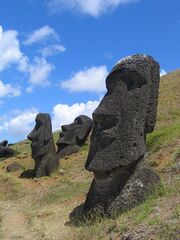
The Polynesians, descendants of the Lapita peoples, colonized vast reaches of Remote Oceania beginning around 1000 CE.[381] They traveled the open ocean in double-hulled canoes up to 37 meters (121 ft) long, each canoe carrying as many as 50 people and their livestock.[382] Their voyages resulted in the colonization of hundreds of islands including the Marquesas, Hawaii, Rapa Nui (Easter Island), and New Zealand.[383]
The TuTemplate:Fakau'ai Tonga Empire was founded in the 10th century CE and expanded between 1250 and 1500.[384] Tongan culture, language, and hegemony spread widely throughout eastern Melanesia, Micronesia, and central Polynesia during this period,[385] influencing east 'Uvea, Rotuma, Futuna, Samoa, and Niue, as well as specific islands and parts of Micronesia (Kiribati, Pohnpei, and miscellaneous outliers), Vanuatu, and New Caledonia (specifically, the Loyalty Islands, with the main island being predominantly populated by the Melanesian Kanaks and their cultures).[386] In Northern Australia, there is evidence that Aboriginal Australians regularly traded with Makassan trepangers from Indonesia before the arrival of Europeans.[387]
The question of pre-Columbian contact between Polynesians and Indigenous Americans has long been controversial.[388] In 2020, a genome-wide DNA analysis of Polynesians and Indigenous South Americans shed new light on the debate by reporting evidence of intermingling between Polynesians and pre-Columbian Zenú around 1200 CE.[388] Whether this happened due to Indigenous Americans reaching eastern Polynesia or because the northern coast of South America was visited by Polynesians is not clear.[389]
On Rapa Nui, the islanders carved hundreds of moai, huge stone monuments that could weigh up to 80 tons.[390] The moai are thought to represent high-ranking ancestors.[391] All were pulled down during the chaotic period following European contact.[392] Rapa Nui is also the only Polynesian island to have a writing system, the rongorongo script, although the script remains undeciphered and it may be proto-writing rather than true writing.[393]
Americas
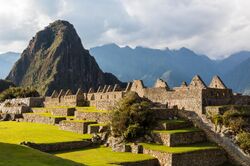
In North America, this period saw the rise of the Mississippian culture in the modern-day United States c. 950 CE,[394] marked by the extensive 11th-century urban complex at Cahokia.[395] The Ancestral Puebloans and their predecessors (9th–13th centuries) built extensive permanent settlements, including stone structures that would remain the largest buildings in North America until the 19th century.[396]
In Mesoamerica, the Teotihuacan civilization fell and the classic Maya collapse occurred.[397] The Aztec Empire came to dominate much of Mesoamerica in the 14th and 15th centuries.[398]
In South America, the 15th century saw the rise of the Inca.[249] The Inca Empire or Tawantinsuyu, with its capital at Cusco, spanned the entire Andes, making it the most extensive pre-Columbian civilization.[399] The Inca were prosperous and advanced, known for an excellent road system and elegant stonework.[400]
Early modern period (c. 1500 CE – c. 1800 CE)
The early modern period was the period between the Middle Ages and the Industrial Revolution—roughly 1500 to 1800.[306] The period was characterized by proto-globalization[401] and the rise of centralized bureaucratic states.[402] European powers came to dominate much of the world by founding maritime empires: first the Portuguese and Spanish Empires, then the French, English, and Dutch Empires.[403][404] Historians still debate the causes of Europe's rise, which is known as the Great Divergence.[405]
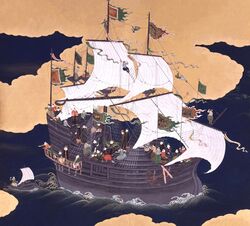
Capitalist economies began their rise, initially in the northern Italian republics and some Asian port cities.[406] The early modern period saw the rise and dominance of mercantilist economic theory, and the decline and eventual disappearance, in much of the European sphere, of serfdom and the power of the Catholic Church.[407] Shortly before the turn of the 16th century, the Portuguese started establishing factories ranging from Africa to Asia and Brazil, for trade in local commodities such as slaves, gold, spices, and sugar.[408] In the 17th century, private chartered companies were established, such as the English East India Company (founded 1600) – often described as the first multinational corporation – and the Dutch East India Company (founded 1602).[409]
The Age of Discovery was the first period in which Eurasia and Africa engaged in substantial cultural, material, and biologic exchange with the New World. It began in the late 15th century, when the two kingdoms of the Iberian Peninsula – Portugal and Castile – sent the first exploratory voyages around the Cape of Good Hope and to the Americas, the latter reached in 1492 by Christopher Columbus.[410] Global integration continued as European colonization of the Americas initiated the Columbian exchange: the exchange of plants, animals, foods, human populations (including slaves), communicable diseases, and culture between the Eastern and Western Hemispheres.[411] It was one of history's most important global events, involving ecology and agriculture.[412] New crops brought from the Americas by 16th-century European seafarers substantially contributed to world population growth.[413]
Greater Middle East
After conquering Constantinople in 1453, the Ottoman Empire quickly came to dominate the Middle East.[414] Persia came under the rule of the Safavids in 1501,[415] succeeded by the Afshars in 1736, the Zands in 1751, and the Qajars in 1794.[416] The Safavids established Shia Islam as Persia's official religion, thus giving Persia a separate identity from its Sunni neighbors.[417] Along with the Mughals in India, the Ottomans and Safavids are known as the gunpowder empires because of their early adoption of firearms.[418] In North Africa, the Berbers remained in control of independent states until the 16th century.[419] At the end of the 18th century, the Russian Empire began its conquest of the Caucasus.[420] The Uzbeks replaced the Timurids as the preeminent power in Central Asia.[421]
Europe

Europe's Renaissance – the "rebirth" of classical culture, beginning in Italy in the 14th century and extending into the 16th[lower-alpha 7] – comprised the rediscovery of the classical world's cultural, scientific, and technological achievements, and the economic and social rise of Europe.[423] The Renaissance engendered a culture of inquisitiveness which ultimately led to humanism[424] and the Scientific Revolution.[425] This period is also celebrated for its artistic and literary attainments.[426] Petrarch's poetry, Giovanni Boccaccio's Decameron, and the paintings and sculptures of Leonardo da Vinci and Michelangelo are some of the great works of the era.[426] Johannes Gutenberg invented movable type printing in 1453,[lower-alpha 8] which helped spread the ideas of the Renaissance, the Scientific Revolution, and the Reformation.[427] The Reformation was an anti-clerical theological and social movement that resulted in the creation of Protestant Christianity.[428] In the aftermath of the Reformation, Protestantism became the majority faith throughout Northwestern Europe and in England and English-speaking America.[429]
In Russia, Ivan the Terrible was crowned in 1547 as the first tsar of Russia, and by annexing the Turkic khanates in the east, transformed Russia into a regional power, eventually replacing the Polish-Lithuanian Commonwealth as a major power in Eastern Europe.[430][431] The countries of Western Europe, while expanding prodigiously through technological advances and colonial conquest, competed with each other economically and militarily in a state of almost constant war.[432] Often the wars had a religious dimension, either Catholic versus Protestant (primarily in Western Europe)[433] or Christian versus Muslim (primarily in Eastern Europe), though religious tolerance was encouraged in countries like the Polish-Lithuanian Commonwealth, which legally guaranteed it with the Warsaw Confederation (1573).[431] Wars of particular note included the Thirty Years' War, the War of the Spanish Succession, the Seven Years' War, and the French Revolutionary Wars.[434] Napoleon Bonaparte became First Consul of France in 1799, concluding the French Revolution . Bonaparte's rise to power foreshadowed the Napoleonic Wars of the early 19th century.[435]
Sub-Saharan Africa
In Africa, this period saw a decline in many civilizations and an advancement in others. Between 1515 and 1800, Africa lost eight million people to the Atlantic slave trade, and two million to the Arab slave trade.[436] The Atlantic trade was the transport of enslaved Africans to the Americas, while the Arab trade consisted of the trans-Saharan and Indian Ocean slave trades.[436] The Swahili Coast was influenced by trade with the Portuguese and later the Omanis.[437] In West Africa, the Songhai Empire fell after an invasion by the Moroccans.[438] Bonoman gave birth to numerous Akan states such as Akwamu, Akyem, Fante, and Adansi, among others.[439] The Kingdom of Zimbabwe gave way to smaller kingdoms such as Mutapa,[440] Butua,[441] and Rozvi.[442]
In the Horn of Africa, the Ajuran Sultanate declined in the 18th century, and was succeeded by the Geledi Sultanate.[443] The Ethiopian Empire suffered from the 1531 invasion by the neighboring Muslim Adal Sultanate,[444] and in 1769 entered the Zemene Mesafint (Age of Princes) during which the Emperor became a figurehead and the country was ruled by warlords, though the royal line later would recover under Emperor Tewodros II.[445] Other civilizations in Africa advanced during this period. The Oyo Empire experienced its golden age, as did the Kingdom of Benin.[446] The Ashanti Empire rose to power in modern-day Ghana in the late 17th century.[447] The Kingdom of Kongo also thrived during this period.[448]
South Asia
In the Indian subcontinent, the Mughal Empire began under Babur in 1526 and lasted for two centuries.[449] Starting in the northwest, the Mughal Empire would come to rule the entire subcontinent by the late 17th century,[450] except for the southernmost Indian provinces, which would remain independent.[451]
Against the Muslim Mughal Empire, the Hindu Maratha Empire was founded by Shivaji on the western coast in 1674.[452] The Marathas gradually gained territory from the Mughals over several decades, particularly in the Mughal–Maratha Wars (1680–1707).[453] The Maratha Empire would fall under the control of the British East India Company in 1818, with all former Maratha and Mughal authority devolving to the British Raj in 1858.[454]
During the same period, Sikhism developed from the spiritual teachings of ten gurus.[455] In 1799, Ranjit Singh established the Sikh Empire in the Punjab.[456] The British East India Company annexed the Sikh Empire after the Second Anglo-Sikh War in 1849.[457]
Northeast Asia
In 1644, the Ming was supplanted by the Qing,[458] the last Chinese imperial dynasty, which would rule until 1912.[459] Japan experienced its Azuchi–Momoyama period (1568–1600), followed by the Edo period (1600–1868).[460] The Korean Joseon dynasty (1392–1910) ruled throughout this period, repelling invasions from Japan and China in the 16th and 17th centuries.[461] Expanded maritime trade with Europe significantly affected China and Japan during this period, particularly through the Portuguese in Macau and the Dutch in Nagasaki.[462] However, China and Japan would later pursue isolationist policies designed to eliminate foreign influences, known as haijin in China and sakoku in Japan.[463]
Southeast Asia
In 1511, the Portuguese overthrew the Malacca Sultanate in present-day Malaysia and Indonesian Sumatra.[464] The Portuguese held this important trading territory (and the valuable associated navigational strait) until overthrown by the Dutch in 1641.[409] The Johor Sultanate, centered on the southern tip of the Malay Peninsula, became the dominant trading power in the region.[465]
European colonization expanded with the Dutch in Indonesia, the Portuguese in Timor, and the Spanish in the Philippines.[466] Into the 19th century, European expansion would affect the whole of Southeast Asia, with the British in Burma, Malaya, and North Borneo, and the French in Indochina.[467] Only Thailand would successfully resist colonization.[467]
Oceania
The Pacific islands of Oceania would also be affected by European contact, starting with the circumnavigational voyage of Ferdinand Magellan (1519–1522),[lower-alpha 9] who landed in the Marianas and other islands.[468] Abel Tasman (1642–1644) sailed to present-day Australia, New Zealand, and nearby islands.[469] James Cook (1768–1779) made the first recorded European contact with Hawaii.[470] In 1788, Britain founded its first Australian colony.[471]
Americas
Several European powers colonized the Americas, largely displacing the native populations and conquering the advanced civilizations of the Aztecs and Inca.[472] Diseases introduced by Europeans devastated American societies, killing 60–90 million people by 1600 and reducing the population by 90–95%.[473] Spain, Portugal, Britain, and France all made extensive territorial claims, and undertook large-scale settlement, including the importation of large numbers of African slaves.[474] Portugal claimed Brazil.[475] Spain claimed the rest of South America, Mesoamerica, and southern North America.[475] The Spanish mined and exported prodigious amounts of silver from the Americas.[476] This American silver boom, along with an increase in Japanese silver mining, caused a surge in inflation known as the Price Revolution in the 16th and 17th centuries.[477]
In North America, Britain colonized the east coast while France settled the central region. Russia made incursions into the northwest coast of North America, with its first colony in present-day Alaska in 1784,[478] and the outpost of Fort Ross in present-day California in 1812.[479] France lost its North American territory to England and Spain after the Seven Years' War (1756–1763).[480] Britain's Thirteen Colonies declared independence as the United States in 1776, ratified by the Treaty of Paris in 1783, ending the American Revolutionary War.[481] In 1791, African slaves launched a successful rebellion in the French colony of Saint-Domingue. France won back its continental claims from Spain in 1800, but sold them to the United States in the Louisiana Purchase of 1803.[482]
Late modern period (c. 1800 CE – present)
The 19th century saw the global spread of the Industrial Revolution, the greatest transformation of the world economy since the Neolithic Revolution.[483] The Industrial Revolution began in Great Britain around 1770 and used new modes of production—the factory, mass production, and mechanization—to manufacture a wide array of goods faster while using less labor than previously required.[484] Industrialization raised the global standard of living but caused upheaval as factory owners and workers clashed over wages and working conditions.[485] Along with industrialization came modern globalization, the increasing interconnection of world regions in the economic, political, and cultural spheres.[486][487] Globalization began in the early 19th century and was enabled by improved transportation technologies such as railroads and steamships.[488]

European empires lost territory in Latin America, which won independence by the 1820s through military campaigns,[489] but expanded elsewhere as their industrial economies gave them an advantage over the rest of the world.[490] Britain gained control of the Indian subcontinent, Burma, Malaya, North Borneo, Hong Kong, and Aden; the French took Indochina; and the Dutch cemented their rule over Indonesia.[467] The British also colonized Canada, Australia, New Zealand, and South Africa with large numbers of British colonists emigrating to these colonies.[491] Russia colonized large pre-agricultural areas of Siberia.[492] In the late 19th century, the European powers divided the remaining areas of Africa.[493] Only Ethiopia and Liberia remained independent.[494]
Within Europe, economic and military challenges created a system of nation states, and ethno-cultural groupings began to identify themselves as distinctive nations with aspirations for cultural and political autonomy.[495] This nationalism would become important to peoples across the world in the 20th century.[496] The first wave of democratization also took place between 1828 and 1926 and saw democratic institutions take root in 33 countries around the world.[497] In a remarkable instance of moral progress, most of the world abolished slavery in the 19th century.[498]

In response to the encroachment of European powers, several countries undertook programs of industrialization and political reform along Western lines.[499] The Meiji Restoration in Japan was successful and led to the establishment of a colonial empire, while the tanzimat reforms in the Ottoman Empire did little to slow Ottoman decline.[500] China achieved some success with its Self-Strengthening Movement, but was devastated by the Taiping Rebellion, history's bloodiest civil war, which killed 20–30 million people between 1850 and 1864.[501][502]
The United States developed to become the world's largest economy by the end of the century.[503] During the Second Industrial Revolution, a new set of technological advances including electric power, the internal combustion engine, and assembly line manufacturing increased productivity once again.[504] Meanwhile, industrial pollution and environmental damage, present since the discovery of fire and the beginning of civilization, accelerated drastically.[505]
The 20th century opened with Europe at an apex of wealth and power,[506] and with much of the world under its direct colonial control or its indirect domination.[507] Much of the rest of the world was influenced by heavily Europeanized nations: the United States and Japan.[507] As the century unfolded, however, the global system dominated by rival powers was subjected to severe strains, and ultimately yielded to a more fluid structure of independent nation states.[508]
This transformation was catalyzed by wars of unparalleled scope and devastation. World War I led to the collapse of four empires – the Austro-Hungarian, German, Ottoman, and Russian Empires[509] – and showed that industrial technology had made traditional military tactics obsolete.[510] The Armenian, Assyrian, and Greek genocides saw the systematic destruction, mass murder, and expulsion of those populations in the Ottoman Empire.[511][512] From 1918 to 1920, the Spanish flu caused the deaths of at least 25 million people.[513]
In the war's aftermath, powerful ideologies rose to prominence. The Russian Revolution of 1917 created the first communist state,[514] while the 1920s and 1930s saw fascist political parties gain control in Italy and Germany.[515][lower-alpha 11] The women's suffrage movement won women the right to vote in numerous countries during the late modern period, ranging from New Zealand (1893) to Portugal (1976).[517] Women fought to expand their civil rights,[518] and began to enjoy greater access to education and the workforce.[519]
Ongoing national rivalries, exacerbated by the economic turmoil of the Great Depression, helped precipitate World War II.[520] In that war, the vast majority of the world's countries, including all the great powers, fought as part of two opposing military alliances: the Allies and the Axis. The leading Axis powers were Germany, Japan, and Italy;[521] while the United Kingdom, the United States, the Soviet Union, and the Republic of China were the "Big Four" Allied powers.[522]
The militaristic governments of Germany and Japan pursued an ultimately doomed course of imperialist expansionism. In the course of doing so, Germany orchestrated the genocide of six million Jews and millions of non-Jews across German-occupied Europe in the Holocaust,[523] while Japan murdered millions of Chinese.[524] Estimates of the war's total casualties range from 55 to 80 million dead.[525] When World War II ended in 1945, the United Nations was founded in the hope of preventing future wars,[526] as the League of Nations had been formed following World War I.[527] Likewise, several European countries began to form a political and economic community, the European Union, which eventually grew to include 27 member states.[528] World War II opened the way for the advance of communism into Eastern and Central Europe, China, North Korea, North Vietnam, and Cuba.[529]
Contemporary history
World War II had left two countries, the United States and the Soviet Union, with principal power to influence international affairs.[530] Each was suspicious of the other and feared a global spread of the other's, respectively capitalist and communist, political-economic model.[531] This led to the Cold War, a 45-year stand-off and arms race between the United States and its allies, on one hand, and the Soviet Union and its allies on the other.[532]
With the development of nuclear weapons during World War II and their subsequent proliferation, all of humanity was put at risk of nuclear war between the two superpowers, as demonstrated by many incidents, most prominently the October 1962 Cuban Missile Crisis.[533] Such war being viewed as impractical, the superpowers instead waged proxy wars in non-nuclear-armed Third World countries.[534][535] The Cold War ended peacefully in 1991 after the Soviet Union collapsed,[536] partly due to its inability to compete economically with the United States and Western Europe.[537]
Cold War preparations to deter or to fight a third world war accelerated advances in technologies that, though conceptualized before World War II, had been implemented for that war's exigencies, such as jet aircraft,[538] rocketry,[539] and computers.[540] In the decades after World War II, these advances led to jet travel;[538] artificial satellites with innumerable applications,[541] including GPS; [542] and the Internet,[541] which in the 1990s began to gain traction as a form of communication.[543] These inventions have revolutionized the movement of people, ideas, and information.[544]
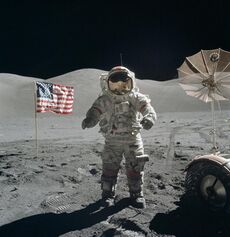
The second half of the 20th century also saw groundbreaking scientific and technological developments such as the discovery of the structure of DNA[545] and DNA sequencing,[546] the worldwide eradication of smallpox,[547] the Green Revolution in agriculture,[548] the discovery of plate tectonics,[549] the moon landings,[550] crewed and uncrewed exploration of space,[551] solar-power and wind-power technologies,[552] and foundational discoveries in physics phenomena ranging from the smallest entities (particle physics) to the greatest entity (physical cosmology).[549]
These technical innovations had far-reaching effects.[553] The world's population quadrupled to six billion during the 20th century, while world economic output increased by a factor of 20.[554] In 1820, 75% of humanity lived on less than one dollar a day, while in 2001 only about 20% did.[555] At the same time, economic inequality increased both within individual countries and between rich and poor countries.[556]
In China, the Maoist government implemented industrialization and collectivization policies as part of the Great Leap Forward (1958–1962), leading to the starvation deaths (1959–1961) of 30–40 million people.[557] After these policies were rescinded, China entered a period of economic liberalization and rapid growth, with the economy expanding by 6.6% per year from 1978 to 2003.[558] In the postwar decades, the African, Asian, and Oceanian colonies of the Belgian, British, Dutch, French, and other European empires won their formal independence, a process known as decolonization.[559] Postcolonial states in Africa struggled to grow their economies, facing structural barriers such as reliance on the export of commodities rather than manufactured goods.[560] Sub-Saharan Africa was the world region hit hardest by the HIV/AIDS pandemic of the late 20th century.[561] Moreover, Africa experienced high levels of violence, exemplified by the Second Congo War (1998–2003), the deadliest conflict since World War II.[562] Latin America also faced economic problems and an over-reliance on commodity exports.[563] Development efforts in Latin America were hindered by political instability, some of which was caused by the United States as it repeatedly intervened in the region.[564]

The early 21st century was marked by growing economic globalization and integration,[565] which brought benefits but also risk to interlinked economies, as exemplified by the Great Recession of the late 2000s and early 2010s.[566] Communications expanded, with smartphones and social media becoming ubiquitous worldwide by the mid 2010s. By the early 2020s, artificial intelligence systems improved to the point of outperforming humans at many circumscribed tasks.[567][568] In 2020, the COVID-19 pandemic substantially disrupted global trading, caused recessions in the global economy, and spurred cultural paradigm shifts.[569][570] Concerns grew as existential threats from environmental degradation and global warming became increasingly evident,[571][572][573] while mitigation efforts, including a shift to sustainable energy, made gradual progress.[574][575][576]
References
Explanatory notes
- ↑ Christopher de Bellaigue writes: "Like the Maya and the Akkadians we have learned that a broken environment aggravates political and economic dysfunction and that the inverse is also true. Like the Qing we rue the deterioration of our soils. But the lesson is never learned. [...] Denialism [...] is one of the most fundamental of human traits and helps explain our current inability to come up with a response commensurate with the perils we face."[2]
- ↑ This date comes from the 2015 discovery of stone tools at the Lomekwi site in Kenya.[9] Some palaeontologists propose an earlier date of 3.39 million years ago based on bones found with butchery marks on them in Dikika, Ethiopia,[10] while others dispute both the Dikika and Lomekwi findings.[11]
- ↑ Or perhaps earlier; the 2018 discovery of stone tools from 2.1 million years ago in Shangchen, China predates the earliest known H. erectus fossils.[19]
- ↑ These dates come from a 2018 study of an upper jawbone from Misliya Cave, Israel.[39] Researchers studying a fossil skull from Apidima Cave, Greece in 2019 proposed an earlier date of 210,000 years ago.[40] The Apidima Cave study has been challenged by other scholars.[41]
- ↑ This occurred during the African humid period, when the Sahara was much wetter than it is today.[58]
- ↑ This is the traditional date for the founding of the Xia dynasty, and has not been confirmed by archaeology.[94] Chinese civilization had its origins in the earlier Yangshao and Longshan cultures (4000–2000 BCE),[95] but the Shang is the first dynasty that can be archeologically verified (1750 BCE).[96]
- ↑ Some scholars date the period later, to the 15th and 16th centuries.[422]
- ↑ The Chinese invented movable type centuries earlier, but it was better suited to the alphabetical writing systems of European languages.[427]
- ↑ Magellan died in 1521. The voyage was completed by Spanish navigator Juan Sebastián Elcano in 1522.[468]
- ↑ BritainFranceSpainPortugalNetherlandsGermanyOttoman EmpireBelgiumRussiaJapanQing EmpireAustria-HungaryDenmarkSweden-NorwayUnited StatesItalyIndependent states
- ↑ Some historians also classify Francoist Spain as a fascist regime.[516]
Citations
- ↑ Ritchie, Hannah; Rodés-Guirao, Lucas; Mathieu, Edouard; Gerber, Marcel; Ortiz-Ospina, Esteban; Hasell, Joe; Roser, Max (11 July 2023). "Population Growth". Our World in Data. https://ourworldindata.org/population-growth.
- ↑ Christopher de Bellaigue, "A World Off the Hinges" (review of Peter Frankopan, The Earth Transformed: An Untold History, Knopf, 2023, 695 pp.), The New York Review of Books, vol. LXX, no. 18 (23 November 2023), pp. 40–42. (p. 41.)
- ↑ Jungers, William L. (June 1988). "Lucy's length: Stature reconstruction in Australopithecus afarensis (A.L.288-1) with implications for other small-bodied hominids". American Journal of Physical Anthropology 76 (2): 227–231. doi:10.1002/ajpa.1330760211. PMID 3137822.
- ↑ Bulliet et al. 2015a, p. 1. "Human beings evolved over several million years from primates in Africa."
- ↑ Christian 2011, p. 150. "But it turned out that humans and chimps differed from each other only by about 10 percent as much as the differences between major groups of mammals, which suggested that they had diverged from each other approximately 5 to 7 million years ago."
- ↑ Dunbar 2016, p. 8. "Conventionally, taxonomists now refer to the great ape family (including humans) as hominids, while all members of the lineage leading to modern humans that arose after the split with the [Homo-Pan] LCA are referred to as hominins. The older literature used the terms hominoids and hominids respectively."
- ↑ 7.0 7.1 Cela-Conde, Camilo; Ayala, Francisco (2003). "Genera of the human lineage". Proceedings of the National Academy of Sciences 100 (13): 7684–7689. doi:10.1073/pnas.0832372100. PMID 12794185. Bibcode: 2003PNAS..100.7684C. ""Only two or three hominid genera, Australopithecus, Paranthropus, and Homo, had been previously accepted, with Paranthropus considered a subgenus of Australopithecus by some authors."".
- ↑ Dunbar 2016, pp. 8, 10. "What has come to define our lineage – bipedalism – was adopted early on after we parted company with the chimpanzees, presumably in order to facilitate travel on the ground in more open habitats where large forest trees were less common....The australopithecines did not differ from the modern chimpanzees in terms of brain size."
- ↑ Harmand, Sonia (2015). "3.3-million-year-old stone tools from Lomekwi 3, West Turkana, Kenya". Nature 521 (7552): 310–315. doi:10.1038/nature14464. PMID 25993961. Bibcode: 2015Natur.521..310H. https://academiccommons.columbia.edu/doi/10.7916/D8697F75/download.
- ↑ McPherron, Shannon P.; Alemseged, Zeresenay; Marean, Curtis W.; Wynn, Jonathan G.; Reed, Denné; Geraads, Denis; Bobe, René; Béarat, Hamdallah A. (August 2010). "Evidence for stone-tool-assisted consumption of animal tissues before 3.39 million years ago at Dikika, Ethiopia". Nature 466 (7308): 857–860. doi:10.1038/nature09248. PMID 20703305. Bibcode: 2010Natur.466..857M.
- ↑ Domínguez-Rodrigo, Manuel; Alcalá, Luis (2016). "3.3-Million-Year-Old Stone Tools and Butchery Traces? More Evidence Needed". PaleoAnthropology: 46–53. https://paleoanthro.org/media/journal/content/PA20160046.pdf.
- ↑ de la Torre, Ignacio (2019). "Searching for the emergence of stone tool making in eastern Africa". Proceedings of the National Academy of Sciences 116 (24): 11567–11569. doi:10.1073/pnas.1906926116. PMID 31164417. Bibcode: 2019PNAS..11611567D.
- ↑ Stutz, Aaron Jonas (2018). "Paleolithic". in Trevathan, Wenda; Cartmill, Matt; Dufour, Darna et al. (in en). The International Encyclopedia of Biological Anthropology. Hoboken: John Wiley & Sons, Inc.. pp. 1–9. doi:10.1002/9781118584538.ieba0363. ISBN 978-1-118-58442-2. https://onlinelibrary.wiley.com/doi/10.1002/9781118584538.ieba0363. "The Paleolithic era encompasses the bulk of the human archaeological record. Its onset is defined by the oldest known stone tools, now dated to 3.3 Ma, found at the Lomekwi site in Kenya.".
- ↑ Strait, David (2010). "The Evolutionary History of the Australopiths" (in en). Evolution: Education and Outreach 3 (3): 341. doi:10.1007/s12052-010-0249-6. ISSN 1936-6434. "However, Homo is almost certainly descended from an australopith ancestor, so at least one or some australopiths belong directly to the human lineage.".
- ↑ Villmoare, Brian; Kimbel, William; Seyoum, Chalachew; Campisano, Christopher; DiMaggio, Erin; Rowan, John et al. (March 2015). "Paleoanthropology. Early Homo at 2.8 Ma from Ledi-Geraru, Afar, Ethiopia". Science 347 (6228): 1352–1355. doi:10.1126/science.aaa1343. PMID 25739410. Bibcode: 2015Sci...347.1352V.
- ↑ Spoor, Fred; Gunz, Philipp; Neubauer, Simon; Stelzer, Stefanie; Scott, Nadia; Kwekason, Amandus; Dean, M. Christopher (2015). "Reconstructed Homo habilis type OH 7 suggests deep-rooted species diversity in early Homo". Nature 519 (7541): 83–86. doi:10.1038/nature14224. PMID 25739632. Bibcode: 2015Natur.519...83S. https://www.researchgate.net/publication/273149772. "The latter is morphologically more derived than OH 7 but 500,000 years older, suggesting that the H. habilis lineage originated before 2.3 million years ago, thus marking deep-rooted species diversity in the genus Homo.".
- ↑ Bulliet et al. 2015a, p. 5. "What most distinguished Homo habilis from the australopithecines was a brain that was nearly 50 percent larger."
- ↑ "Contemporaneity of Australopithecus, Paranthropus, and early Homo erectus in South Africa". Science 368 (6486): 7293. April 2020. doi:10.1126/science.aaw7293. PMID 32241925.
- ↑ "Hominin occupation of the Chinese Loess Plateau since about 2.1 million years ago". Nature 559 (7715): 608–612. July 2018. doi:10.1038/s41586-018-0299-4. PMID 29995848. Bibcode: 2018Natur.559..608Z. ""Fourth, and most importantly, the oldest artefact age of approximately 2.12 Ma at Shangchen implies that hominins had left Africa before the date suggested by the earliest evidence from Dmanisi (about 1.85 Ma). This makes it necessary to reconsider the timing of initial dispersal of early hominins in the Old World."".
- ↑ Dunbar 2016, p. 10.
- ↑ Gowlett, J. A. J. (23 May 2016). "The discovery of fire by humans: a long and convoluted process". Philosophical Transactions of the Royal Society B: Biological Sciences 371 (1696): 20150164. doi:10.1098/rstb.2015.0164. PMID 27216521. ""We know that burning evidence occurs on numbers of archaeological sites from about 1.5 Ma onwards (there is evidence of actual hearths from around 0.7 to 0.4 Ma); that more elaborate technologies existed from around half a million years ago, and that these came to employ adhesives that require preparation by fire."".
- ↑ Christian 2015, p. 11.
- ↑ Christian 2015, p. 400n.
- ↑ Dunbar 2016, p. 11.
- ↑ "Human Hybrids". Scientific American 308 (5): 66–71. May 2013. doi:10.1038/scientificamerican0513-66. PMID 23627222. Bibcode: 2013SciAm.308e..66H. https://www.grochbiology.org/EarlyHominidInterbreeding.pdf.
- ↑ "Mosaic humans, the hybrid species". New Scientist 211 (2823): 34–38. July 2011. doi:10.1016/S0262-4079(11)61839-3. Bibcode: 2011NewSc.211...34Y.
- ↑ "The Hybrid Origin of "Modern" Humans". Evolutionary Biology 43 (1): 1–11. October 2015. doi:10.1007/s11692-015-9348-1.
- ↑ "Genetic history of an archaic hominin group from Denisova Cave in Siberia". Nature 468 (7327): 1053–1060. December 2010. doi:10.1038/nature09710. PMID 21179161. Bibcode: 2010Natur.468.1053R.
- ↑ "The shaping of modern human immune systems by multiregional admixture with archaic humans". Science 334 (6052): 89–94. October 2011. doi:10.1126/science.1209202. PMID 21868630. Bibcode: 2011Sci...334...89A.
- ↑ "New fossils from Jebel Irhoud, Morocco and the pan-African origin of Homo sapiens". Nature 546 (7657): 289–292. June 2017. doi:10.1038/nature22336. PMID 28593953. Bibcode: 2017Natur.546..289H. https://kar.kent.ac.uk/62267/1/Submission_288356_1_art_file_2637492_j96j1b.pdf.
- ↑ Christian 2015, p. 319.
- ↑ Christian 2015, pp. 319–320, 330, 354.
- ↑ Christian 2015, pp. 344–346.
- ↑ McNeill & McNeill 2003, pp. 17–18.
- ↑ Christian 2015, pp. 357–358, 409.
- ↑ Christian 2015, p. 22. "Most Paleolithic communities lived by foraging, nomadizing over familiar territories."
- ↑ Gavashelishvili, Alexander; Tarkhnishvili, David (2016). "Biomes and human distribution during the last ice age". Global Ecology and Biogeography 25 (5): 563–574. doi:10.1111/geb.12437.
- ↑ Weber, Gerhard W.; Hershkovitz, Israel; Gunz, Philipp; Neubauer, Simon; Ayalon, Avner; Latimer, Bruce; Bar-Matthews, Miryam; Yasur, Gal et al. (20 June 2020). "Before the massive modern human dispersal into Eurasia: A 55,000-year-old partial cranium from Manot Cave, Israel" (in en). Quaternary International 551: 29–39. doi:10.1016/j.quaint.2019.10.009. ISSN 1040-6182. Bibcode: 2020QuInt.551...29W. https://www.sciencedirect.com/science/article/pii/S1040618219308080. Retrieved 17 August 2022.
- ↑ Herschkovitz, Israel (26 January 2018). "The earliest modern humans outside Africa". Science 359 (6374): 456–459. doi:10.1126/science.aap8369. PMID 29371468. Bibcode: 2018Sci...359..456H.
- ↑ Harvati, Katerina; Röding, Carolin; Bosman, Abel M.; Karakostis, Fotios A.; Grün, Rainer; Stringer, Chris; Karkanas, Panagiotis; Thompson, Nicholas C. et al. (10 July 2019). "Apidima Cave fossils provide earliest evidence of Homo sapiens in Eurasia" (in en). Nature 571 (7766): 500–504. doi:10.1038/s41586-019-1376-z. ISSN 1476-4687. PMID 31292546. https://www.nature.com/articles/s41586-019-1376-z. Retrieved 10 July 2022.
- ↑ Rosas, Antionio; Bastir, Markus (1 January 2020). "An assessment of the late Middle Pleistocene occipital from Apidima 1 skull (Greece)" (in en). L'Anthropologie 124 (1): 102745. doi:10.1016/j.anthro.2020.102745. ISSN 0003-5521. https://www.sciencedirect.com/science/article/pii/S0003552120300042. Retrieved 17 August 2022.
- ↑ 42.0 42.1 Christian 2015, p. 283.
- ↑ O'Connell, J. F.; Allen, J.; Williams, M. A. J.; Williams, A. N.; Turney, C. S. M.; Spooner, N. A.; Kamminga, J.; Brown, G. et al. (2018). "When did Homo sapiens first reach Southeast Asia and Sahul?". Proceedings of the National Academy of Sciences 115 (34): 8482–8490. doi:10.1073/pnas.1808385115. PMID 30082377. Bibcode: 2018PNAS..115.8482O.
- ↑ "Pleistocene Mitochondrial Genomes Suggest a Single Major Dispersal of Non-Africans and a Late Glacial Population Turnover in Europe". Current Biology 26 (6): 827–833. March 2016. doi:10.1016/j.cub.2016.01.037. PMID 26853362.
- ↑ "Human occupation of northern Australia by 65,000 years ago". Nature 547 (7663): 306–310. July 2017. doi:10.1038/nature22968. PMID 28726833. Bibcode: 2017Natur.547..306C.
- ↑ Bennett, Matthew (23 September 2021). "Evidence of humans in North America during the Last Glacial Maximum". Science 373 (6562): 1528–1531. doi:10.1126/science.abg7586. PMID 34554787. Bibcode: 2021Sci...373.1528B. https://www.science.org/doi/10.1126/science.abg7586. Retrieved 24 September 2021.
- ↑ Christian 2015, p. 316. "Dispersal over an unprecedented swath of the globe...coincided with an Ice Age that...spread ice in the northern hemisphere as far south as the present lower courses of the Missouri and Ohio rivers in North America and deep into what are now the British Isles. Ice covered what is today Scandinavia. Most of the rest of what is now Europe was tundra or taiga. In central Eurasia, tundra reached almost to the present latitudes of the Black Sea. Steppe licked the shores of the Mediterranean. In the New World, tundra and taiga extended to where Virginia is today."
- ↑ Christian 2015, p. 400. "In any case, by the end of the era of climatic fluctuation, humans occupied almost all the habitats their descendants occupy today, with the exception of relatively remote parts of the Pacific, accessible only by high-seas navigation and unsettled, as far as we know, for many millennia more."
- ↑ Christian 2015, pp. 321, 406, 440–441.
- ↑ Koch, Paul L.; Barnosky, Anthony D. (1 January 2006). "Late Quaternary Extinctions: State of the Debate". Annual Review of Ecology, Evolution, and Systematics 37 (1): 215–250. doi:10.1146/annurev.ecolsys.34.011802.132415.
- ↑ Christian 2015, p. 406.
- ↑ 52.0 52.1 Lewin, Roger (2009). Human Evolution: An Illustrated Introduction (5th ed.). Malden, Massachusetts: John Wiley & Sons. p. 247. ISBN 978-1-4051-5614-1. https://books.google.com/books?id=xryuw8sqNsoC. ""The date of 12,000 years before present (BP) is usually given as the beginning of what has been called the Agricultural (or Neolithic) Revolution...The tremendous changes wrought during the Neolithic can be seen as a prelude to the emergence of cities and city states and, of course, to a further rise in population.""
- ↑ Stephens, Lucas; Fuller, Dorian; Boivin, Nicole; Rick, Torben; Gauthier, Nicolas; Kay, Andrea; Marwick, Ben; Armstrong, Chelsey Geralda et al. (30 August 2019). "Archaeological assessment reveals Earth's early transformation through land use". Science 365 (6456): 897–902. doi:10.1126/science.aax1192. ISSN 0036-8075. PMID 31467217. Bibcode: 2019Sci...365..897S.
- ↑ Larson, G.; Piperno, D. R.; Allaby, R. G.; Purugganan, M. D.; Andersson, L.; Arroyo-Kalin, M.; Barton, L.; Climer Vigueira, C. et al. (2014). "Current perspectives and the future of domestication studies". PNAS 111 (17): 6139–6146. doi:10.1073/pnas.1323964111. PMID 24757054. Bibcode: 2014PNAS..111.6139L.
- ↑ McNeill 1999, p. 11.
- ↑ Barker & Goucher 2015, pp. 325, 336. "More recent improvements in archaeobotanical recovery have indicated that rice domestication was underway durin...the Hemudu cultural phase in the lower Yangtze valley...This points to a start of cultivation in this region of c. 10,000–9,000 years ago; in the middle Yangtze valley it could have begun someone earlier but may represent a parallel process to the lower Yangtze...it has been suggested on the basis of phytolith and starch residue evidence that broomcorn and foxtail millet were already in use in northern China prior to 7000 BCE. Nonetheless, the most abundant macrofossil evidence of broomcorn and foxtail millet is found in association with the early Neolithic sites post-7000 BCE."
- ↑ Barker & Goucher 2015, p. 323.
- ↑ Barker & Goucher 2015, p. 59.
- ↑ 59.0 59.1 59.2 Bulliet et al. 2015a, p. 21.
- ↑ Barker & Goucher 2015, p. 265.
- ↑ Barker & Goucher 2015, p. 518. "Arrowroot was the earliest domesticate [in Panama], dating to 7800 BC at the Cueva de los Vampiros site and 5800 BCE at Aguadulce...Plant domestication began before 8500 BCE in southwest coastal Ecuador. Squash phytoliths were recovered from terminal Pleistocene and early Holocene strata at Vegas sites. Phytoliths recovered from the earliest levels are from wild squash, with domesticated size squash phytoliths directly dated to 9840–8555 BCE."
- ↑ Barker & Goucher 2015, p. 85.
- ↑ Bulliet et al. 2015a, p. 202.
- ↑ Adovasio, J. M.; Soffer, Olga; Page, Jake (2007). The Invisible Sex: Uncovering the True Roles of Women in Prehistory. Pymble, NSW: HarperCollins e-books. pp. 243, 257. ISBN 978-0-06-157177-0. OCLC 191804695.
- ↑ Barker & Goucher 2015, p. 218.
- ↑ Barker & Goucher 2015, p. 95.
- ↑ Barker & Goucher 2015, pp. 216–218.
- ↑ Roberts & Westad 2013, pp. 34–35.
- ↑ Yoffee 2015, pp. 313, 391.
- ↑ Barker & Goucher 2015, p. 193.
- ↑ Yoffee 2015, pp. 313–316.
- ↑ McNeill 1999, p. 13.
- ↑ Barker & Goucher 2015, pp. 161–162, 172–173.
- ↑ Bulliet et al. 2015a, p. 99.
- ↑ Barker & Goucher 2015, p. 574.
- ↑ Radivojevic, M; Rehren, T; Kuzmanovic-Cvetkovic, J; Jovanovic, M; Northover, JP (2013). "Tainted ores and the rise of tin bronzes in Eurasia, c.6500 years ago". Antiquity 87 (338): 1030–1045. doi:10.1017/S0003598X0004984X. http://discovery.ucl.ac.uk/1420706/.
- ↑ Headrick 2009, pp. 30–31.
- ↑ Bulliet et al. 2015a, p. 19.
- ↑ Kinzel, Moritz; Clare, Lee (2020). "Monumental – compared to what? A perspective from Göbekli Tepe". in Gebauer, Anne Birgitte. Monumentalising Life in the Neolithic: Narratives of Change and Continuity. Oxford: Oxbow. pp. 32–33. ISBN 978-1-78925-495-2. https://books.google.com/books?id=S6QGEAAAQBAJ. Retrieved 9 September 2022.
- ↑ 81.0 81.1 Barker & Goucher 2015, p. 224.
- ↑ Barker & Goucher 2015, pp. 135, 253–255.
- ↑ Barker & Goucher 2015, p. 135.
- ↑ Croucher, Karina (2012) (in en). Death and Dying in the Neolithic Near East. Oxford University Press. p. 93. ISBN 978-0-19-969395-5. https://books.google.com/books?id=z36INLsPwMIC. Retrieved 12 September 2022.
- ↑ McClellan, James E.; Dorn, Harold (2006). Science and Technology in World History: An Introduction. Baltimore: Johns Hopkins University Press. p. 41. ISBN 978-0-8018-8360-6. https://books.google.com/books?id=aJgp94zNwNQC.
- ↑ Roberts & Westad 2013, p. 46.
- ↑ Stearns & Langer 2001, p. 21.
- ↑ Roberts & Westad 2013, p. 53.
- ↑ Bard 2000, p. 63.
- ↑ Roberts & Westad 2013, p. 70.
- ↑ Graeber & Wengrow 2021, p. 314.
- ↑ Chakrabarti, Dilip K. (2004). "Introduction". in Chkrabarti, Dilip K.. Indus Civilization Sites in India: New Discoveries. Mumbai: Marg Publications. pp. 10–13. ISBN 978-81-85026-63-3.
- ↑ Allchin, Bridget; Allchin, Raymond (1997). Origins of a Civilization: The Prehistory and Early Archaeology of South Asia. New Delhi: Viking. pp. 153–168. ISBN 978-0-670-87713-3.
- ↑ 94.0 94.1 Ropp 2010, p. 2.
- ↑ Tignor et al. 2014, p. 71.
- ↑ Ropp 2010, pp. 2–3.
- ↑ Bulliet et al. 2015a, p. 23.
- ↑ Headrick 2009, p. 32.
- ↑ Roberts & Westad 2013, p. 59.
- ↑ 100.0 100.1 100.2 Bulliet et al. 2015a, p. 35.
- ↑ Roberts & Westad 2013, p. 91.
- ↑ 102.0 102.1 McNeill 1999, p. 16.
- ↑ McNeill 1999, p. 18.
- ↑ Johnston, Sarah Iles, ed (2004). Religions of the Ancient World: A Guide. Cambridge, Massachusetts: The Belknap Press of Harvard University Press. pp. 13, 19. ISBN 978-0-674-01517-3. http://archive.org/details/religionsofancie0000unse_d0s1.
- ↑ Roberts & Westad 2013, pp. 43–46.
- ↑ Yoffee 2015, p. 118.
- ↑ Regulski, Ilona (2 May 2016). "The Origins and Early Development of Writing in Egypt" (in en). Oxford Handbooks Online. doi:10.1093/oxfordhb/9780199935413.013.61. https://www.oxfordhandbooks.com/view/10.1093/oxfordhb/9780199935413.001.0001/oxfordhb-9780199935413-e-61.
- ↑ {{cite book|last=Wengrow|first=David
Bibliography
- Allison, Graham (July–August 2018). "The Myth of the Liberal Order: From Historical Accident to Conventional Wisdom". Foreign Affairs 97 (4): 124–133. https://www.foreignaffairs.com/articles/2018-06-14/myth-liberal-order. Retrieved 3 July 2022.
- Axworthy, Michael (2008). A History of Iran: Empire of the Mind. New York: Basic Books. ISBN 978-0-465-00888-9. http://archive.org/details/historyofiranemp0000axwo.
- Bard, Kathryn A. (2000). "The Emergence of the Egyptian State (c. 3200–2686 BC)". in Shaw, Ian. The Oxford History of Ancient Egypt. Oxford, UK: Oxford University Press. pp. 57–82. ISBN 978-0-19-280458-7. https://archive.org/details/oxfordhistoryofa00shaw/page/57.
- Barker, Graeme; Goucher, Candace, eds (2015). A World with Agriculture, 12,000 BCE–500 CE. The Cambridge World History. 2. Cambridge: Cambridge University Press. ISBN 978-0-521-19218-7. https://books.google.com/books?id=Ri07CQAAQBAJ.
- Benjamin, Craig, ed (2015). A World with States, Empires, and Networks, 1200 BCE–900 CE. The Cambridge World History. 4. Cambridge: Cambridge University Press. ISBN 978-1-107-01572-2. https://books.google.com/books?id=LAFuCAAAQBAJ.
- Bentley, Jerry; Subrahmanyam, Sanjay; Wiesner-Hanks, Merry, eds (2015a). The Construction of a Global World, 1400–1800 CE, Part 1, Foundations. The Cambridge World History. 6. Cambridge University Press. doi:10.1017/CBO9781139194594. ISBN 978-0-521-76162-8. https://books.google.com/books?id=ilxWtAEACAAJ.
- Bentley, Jerry; Subrahmanyam, Sanjay; Wiesner-Hanks, Merry, eds (2015b). The Construction of a Global World, 1400–1800 CE, Part 2, Patterns of Change. The Cambridge World History. 6. Cambridge University Press. doi:10.1017/CBO9781139022460. ISBN 978-0-521-19246-0. https://books.google.com/books?id=tJtrCgAAQBAJ.
- Brown, Cynthia Stokes (2007). Big History: From the Big Bang to the Present. New York: New Press. ISBN 978-1-59558-196-9. http://archive.org/details/bighistoryfrombi0000brow.
- Bulliet, Richard; Crossley, Pamela; Headrick, Daniel; Hirsch, Steven; Johnson, Lyman; Northrup, David (2015a). The Earth and Its Peoples: A Global History. 1 (6th ed.). Stamford, Connecticut: Cengage Learning. ISBN 978-1-285-44567-0. https://books.google.com/books?id=KWqOCwAAQBAJ.
- Bulliet, Richard; Crossley, Pamela; Headrick, Daniel; Hirsch, Steven; Johnson, Lyman; Northrup, David (2015b). The Earth and Its Peoples: A Global History. 2 (6th ed.). Stamford, Connecticut: Cengage Learning. ISBN 978-1-285-44570-0. https://archive.org/details/earthitspeoplesg0000unse_a0j7.
- Christian, David (2011) (in en). Maps of Time: An Introduction to Big History. Berkeley: University of California Press. ISBN 978-0-520-27144-9. https://books.google.com/books?id=xFHOahfX0R4C.
- Christian, David, ed (2015). Introducing World History, to 10,000 BCE. The Cambridge World History. 1. Cambridge: Cambridge University Press. doi:10.1017/CBO9781139194662. ISBN 978-0-521-76333-2. https://books.google.com/books?id=VWwaCAAAQBAJ.
- Collins, Roger (1999). Early Medieval Europe: 300–1000 (2nd ed.). New York: St. Martin's Press. ISBN 978-0-312-21886-7.
- Diamond, Jared (1997). Guns, Germs, and Steel. New York: W. W. Norton, updated eds., 2003, 2007.
- Dunbar, Robin (2016). Human Evolution: Our Brains and Behavior. Oxford: Oxford University Press. ISBN 978-0-19-061678-6. https://archive.org/details/humanevolutionou0000dunb/.
- Fagan, Brian M. (2005). Ancient North America: The Archaeology of a Continent (4th ed.). New York: Thames & Hudson Inc.. ISBN 978-0-500-28148-2.
- Fage, John; Tordoff, William (2002). A History of Africa (4th ed.). New York: Routledge. ISBN 0-415-25247-4. https://archive.org/details/historyofafrica0000fage/.
- Flenley, John; Bahn, Paul (2003). The Enigmas of Easter Island. Oxford: Oxford University Press. ISBN 978-0-19-164719-2. https://archive.org/details/enigmasofeasteri0000flen.
- Gernet, Jacques (1996). A History of Chinese Civilization. Cambridge, UK: Cambridge University Press. ISBN 978-0-521-49781-7. https://archive.org/details/historyofchinese00gern_0.
- Graeber, David; Wengrow, David (2021). The Dawn of Everything: A New History of Humanity. Farrar, Straus and Giroux. ISBN 978-0-374-15735-7. https://books.google.com/books?id=9xkQEAAAQBAJ.
- Headrick, Daniel R. (2009). Technology: A World History. Oxford: Oxford University Press. ISBN 978-0-19-533821-8. https://books.google.com/books?id=_WgSDAAAQBAJ.
- Henshall, Kenneth (1999). A History of Japan: From Stone Age to Superpower. St. Martin's Press. ISBN 0-312-21986-5. https://archive.org/details/historyofjapan00kenn/.
- Hourani, Albert (1991). A History of the Arab Peoples. New York: MJF Books. ISBN 978-1-56731-216-4. http://archive.org/details/historyofarabpeo0000hour.
- Iliffe, John (2007). Africans: The History of a Continent (2nd ed.). Cambridge University Press. ISBN 978-0-521-68297-8. https://archive.org/details/africanshistoryo00ilif/.
- Keay, John (2000). India: A History. New York: Atlantic Monthly Press. ISBN 978-0-87113-800-2. http://archive.org/details/indiahistory00keay.
- Kedar, Benjamin; Wiesner-Hanks, Merry, eds (2015). Expanding Webs of Exchange and Conflict, 500 CE–1500 CE. The Cambridge World History. 5. Cambridge: Cambridge University Press. ISBN 978-0-521-19074-9. https://books.google.com/books?id=Jv9tCAAAQBAJ.
- Lieberman, Victor B. (2003). Strange Parallels: Southeast Asia in Global Context, c. 800–1830, volume 1, Integration on the Mainland. Cambridge University Press. ISBN 978-0-521-80496-7. https://books.google.com/books?id=-01JisWpJbEC.
- McNeill, J. R.; McNeill, William (2003). The Human Web: A Bird's-eye View of World History. New York: Norton. ISBN 0-393-05179-X. https://archive.org/details/humanwebbirdseye0000mcne_d8z9.
- McNeill, J. R.; Pomeranz, Kenneth, eds (2015a). Production, Destruction and Connection, 1750-Present, Part 1, Structures, Spaces, and Boundary Making. The Cambridge World History. 7. Cambridge University Press. doi:10.1017/CBO9781139196079. ISBN 978-1-108-40775-5. https://books.google.com/books?id=SRL0CAAAQBAJ.
- McNeill, J. R.; Pomeranz, Kenneth, eds (2015b). Production, Destruction and Connection, 1750–Present, Part 2, Shared Transformations?. The Cambridge World History. 7. Cambridge University Press. ISBN 978-0-521-19964-3. https://books.google.com/books?id=OBuzCAAAQBAJ.
- McNeill, William H. (1999). A World History (4th ed.). New York: Oxford University Press. ISBN 978-0-19-511616-8. https://archive.org/details/worldhistory0000mcne_e1t4.
- Naughton, John (2016). "The evolution of the Internet: from military experiment to General Purpose Technology". Journal of Cyber Policy 1 (1): 5–28. doi:10.1080/23738871.2016.1157619. ISSN 2373-8871.
- Roberts, J. M.; Westad, Odd Arne (2013). The Penguin History of the World (6th ed.). New York: Penguin Books. ISBN 978-1-84614-443-1. https://books.google.com/books?id=A2cfZkU5aQgC.
- Ropp, Paul S. (2010). China in World History. Oxford: Oxford University Press. ISBN 978-0-19-979876-6. https://books.google.com/books?id=M0u4YGxog3QC.
- Schoppa, R. Keith (2021). The Twentieth Century: A World History. Oxford: Oxford University Press. ISBN 978-0-19-049735-4. https://books.google.com/books?id=aX0_EAAAQBAJ.
- The Encyclopedia of World History: Ancient, Medieval, and Modern, Chronologically Arranged (6th ed.). Boston: Houghton Mifflin Company. 2001. ISBN 978-0-395-65237-4. https://archive.org/details/encyclopediaofwo0000unse_i2x5.
- Tignor, Robert; Adelman, Jeremy; Brown, Peter; Elman, Benjamin; Liu, Xinru; Pittman, Holly; Shaw, Brent (2014). Worlds Together, Worlds Apart, Volume One: Beginnings Through the 15th Century (4th ed.). New York: W.W. Norton & Company. ISBN 978-0-393-92208-0. http://archive.org/details/worldstogetherwo0001tign.
- Tindall, George; Shi, David (2010). America: A Narrative History. 1 (8th ed.). Norton. ISBN 978-0-393-93406-9.
- Uhlig, Siegbert, ed (2017) (in en). Ethiopia: History, Culture and Challenges. Münster: LIT Verlag. ISBN 978-3-643-90892-6. https://archive.org/details/ethiopiahistoryc0000unse.
- Wolpert, Stanley (1997). A New History of India (5th ed.). Oxford: Oxford University Press. ISBN 0-19-510030-1.
- Xue, Zongzheng (1992). A History of Turks. Beijing: Chinese Social Sciences Press.
- Yoffee, Norman, ed (2015). Early Cities in Comparative Perspective, 4000 BCE–1200 CE. The Cambridge World History. 3. Cambridge: Cambridge University Press. ISBN 978-0-521-19008-4. https://books.google.com/books?id=SQS7BwAAQBAJ.
Further reading
- Enrigue, Álvaro, "The Discovery of Europe" (review of Caroline Dodds Pennock, On Savage Shores: How Indigenous Americans Discovered Europe, Knopf, 2023, 302 pp.), The New York Review of Books, vol. LXXI, no. 1 (18 January 2024), pp. 34–35, 39. Caroline Dodds Pennock writes: "We need to invert our understanding of encounter to see transatlantic migration and connection not just as stretching to the west, but also as originating there." (p. 34.) According to the reviewer, "Until now the experiences of indigenous Americans in Europe had not been put together in one place.... On Savage Shores... sets the methodological standard for a new way of understanding the origin of the modern world." (p. 39.)
Lua error in package.lua at line 80: module 'Module:Portal/images/h' not found.
 |
 KSF
KSF